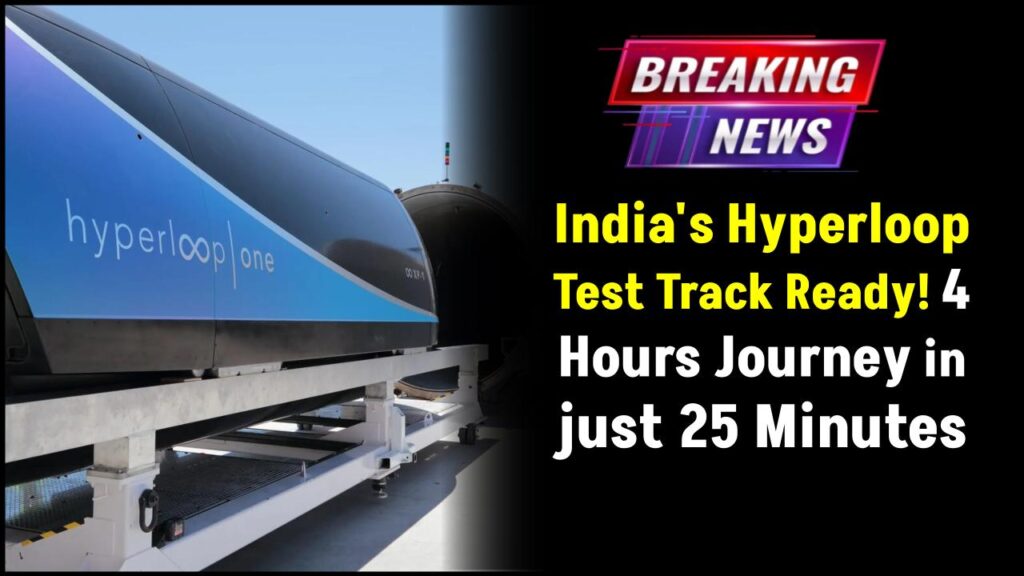Hyperloop Breakthrough: In an era where speed and efficiency define the future of travel, India has taken a monumental step toward revolutionizing transportation. The country recently completed its first-ever Hyperloop test track at the prestigious Indian Institute of Technology (IIT) Madras. This marks a significant milestone in the development of a high-speed transportation system that promises to slash travel times drastically, with the potential to cut a 4-hour journey to just 25 minutes.

This breakthrough not only has the potential to reshape the way people travel in India but also offers an exciting glimpse into the future of ultra-fast transportation. The Hyperloop system, which promises to whisk passengers at speeds of over 1,000 kilometers per hour, is on the brink of transforming intercity travel forever. In this article, we’ll explore what the Hyperloop is, how the test track at IIT Madras works, and what this development means for the future of Indian transportation.
Hyperloop Breakthrough
| Topic | Details |
|---|---|
| What is Hyperloop? | A high-speed transportation system using pods that travel through low-pressure tubes, offering speeds of over 1,000 km/h. |
| Test Track Location | The first test track is located at IIT Madras and spans 410 meters. |
| Projected Benefits | Journey times between major cities like Mumbai and Pune could be reduced from 3–4 hours to just 25 minutes. |
| Potential Impact | Faster and more energy-efficient travel, reducing traffic congestion and environmental impact. |
| Future Outlook | Extensive testing is required before full implementation, with safety and infrastructure improvements in the works. |
| Official Website | IIT Madras Hyperloop Test Track |
India’s Hyperloop test track at IIT Madras is a significant step forward in the quest for ultra-high-speed transportation. With the potential to revolutionize travel, reduce journey times, and provide an energy-efficient alternative to traditional methods, the Hyperloop represents the future of transportation. While there’s still much to be done before it’s ready for public use, the completion of the test track brings us one step closer to experiencing travel speeds previously thought impossible.
What Is Hyperloop?
The Hyperloop concept was first introduced by Elon Musk in 2013 as a new form of transportation that could revolutionize long-distance travel. Essentially, it involves pods or capsules that travel at incredible speeds through a low-pressure tube. These pods are designed to be levitated and propelled by a combination of magnetic fields and air pressure, significantly reducing friction and allowing for faster, more energy-efficient travel.
In traditional transportation, especially high-speed trains and airplanes, friction and air resistance are major obstacles that slow down the speed and efficiency of travel. The Hyperloop, by contrast, eliminates much of these challenges, offering the promise of reaching speeds of up to 1,000 km/h or more. To put this in perspective, that’s faster than the speed of sound, and far quicker than even the fastest bullet trains currently in operation.
Key Features of the Hyperloop:
- Magnetic Levitation: This technology allows the pods to “float” above the track, reducing friction and enabling high speeds.
- Low-Pressure Tubes: The low-pressure environment inside the tubes reduces air resistance, further enhancing the pod’s speed.
- Energy-Efficiency: Due to minimal friction, the Hyperloop is an energy-efficient mode of transport compared to traditional vehicles and trains.
For a more in-depth explanation of how Hyperloop works, you can explore resources like Wikipedia.
India’s Hyperloop Test Track at IIT Madras
India’s journey into the world of Hyperloop transportation has begun with the completion of its first test track at IIT Madras, one of the country’s leading academic institutions. This 410-meter facility serves as a testing ground for Hyperloop technology, offering a platform for engineers and scientists to refine and perfect the system.
The test track was built in collaboration between India’s government and leading academic institutions, marking a significant step toward making Hyperloop travel a reality. The development of this track is not only a technological achievement but also a testament to India’s growing interest and investment in cutting-edge infrastructure projects.
Why IIT Madras?
IIT Madras was selected as the location for the test track due to its world-class research capabilities and infrastructure. The university has long been at the forefront of innovation, and its involvement in this project ensures that the development of the Hyperloop is guided by the best scientific minds in the country.
The test track itself is designed to simulate the conditions and challenges that would be faced in a full-scale operational system, including challenges related to air pressure, pod design, and safety protocols. The test track will help engineers test different components and work toward solutions for potential issues.
Hyperloop Breakthrough: How Will the Hyperloop Impact Travel in India?
The Hyperloop system has the potential to dramatically reshape the way people travel in India. Currently, many journeys between major cities like Mumbai, Pune, and Delhi can take several hours. For instance, the journey from Mumbai to Pune currently takes about 3 to 4 hours by car or train. However, once the Hyperloop is operational, this trip could be completed in just 25 minutes.
Such a drastic reduction in travel time could have several positive effects:
- Increased Efficiency: People can spend less time traveling and more time at their destinations, which could significantly enhance productivity and efficiency, especially for business travelers.
- Economic Benefits: With quicker transportation, cities can become more interconnected, which could foster economic growth, improve job opportunities, and encourage tourism.
- Environmental Impact: Because the Hyperloop is energy-efficient, it could significantly reduce the carbon footprint associated with traditional forms of transportation.
Real-World Example:
If you’ve ever made the journey from Delhi to Jaipur, which can take up to 5 hours by car, imagine being able to complete the trip in just 30 minutes. This example demonstrates the massive time savings that the Hyperloop could offer, making cities more accessible and reducing the overall burden of travel.
Testing and Safety: What Needs to Be Done Before Full Implementation?
While the completion of the test track is an exciting milestone, it’s just the beginning. Before Hyperloop systems can be implemented for public use, extensive testing and further development are required. This includes:
1. Safety Testing
Ensuring that the Hyperloop is safe for passengers is a top priority. This includes testing the structural integrity of the pods, as well as emergency procedures in case of system failures.
2. Infrastructure Development
The Hyperloop will require significant infrastructure, including the construction of the low-pressure tubes, stations, and other facilities. In addition, considerations like urban planning and land acquisition will play a role in determining where the system can be implemented.
3. Regulatory Approvals
Before Hyperloop systems can be launched, they must undergo regulatory approvals. These approvals ensure that the system meets safety standards and environmental guidelines.
4. Public Acceptance
Finally, the public’s acceptance and readiness to adopt the Hyperloop will play a major role. Education, awareness campaigns, and demonstrations will be critical in winning people’s trust in this new mode of transport.
FAQs on Hyperloop Breakthrough
1. What is the Hyperloop, and how does it work?
The Hyperloop is a high-speed transportation system that uses magnetic levitation to propel pods through low-pressure tubes. This reduces friction and air resistance, allowing the pods to travel at speeds exceeding 1,000 km/h.
2. How long will it take to travel from Mumbai to Pune using Hyperloop?
The journey from Mumbai to Pune, which typically takes 3–4 hours, could be reduced to just 25 minutes using the Hyperloop system.
3. What are the environmental benefits of the Hyperloop?
The Hyperloop is energy-efficient, which could help reduce the carbon footprint of transportation. Additionally, it may reduce the need for fossil fuel-powered vehicles.
4. When will the Hyperloop be available for public use?
While the test track is now complete, extensive testing and development are required before the Hyperloop can be implemented for public use. This could take several years, depending on regulatory approvals and infrastructure development.





